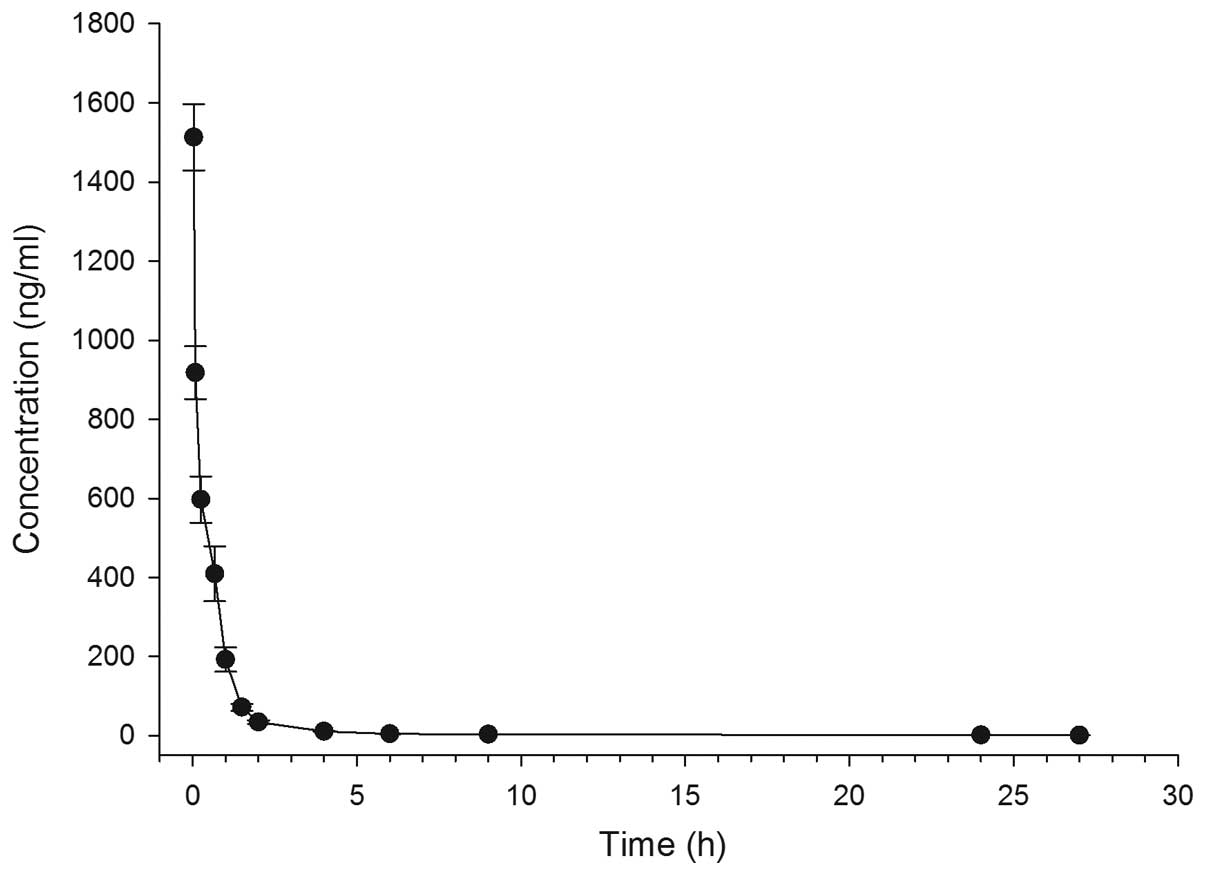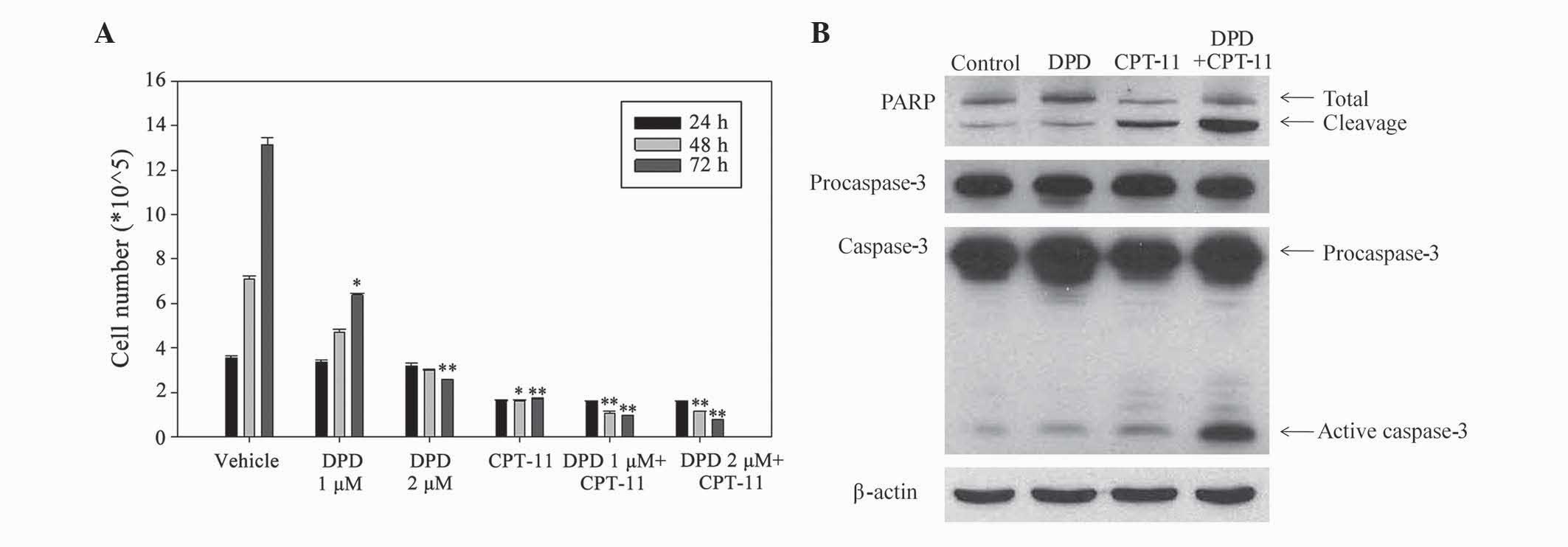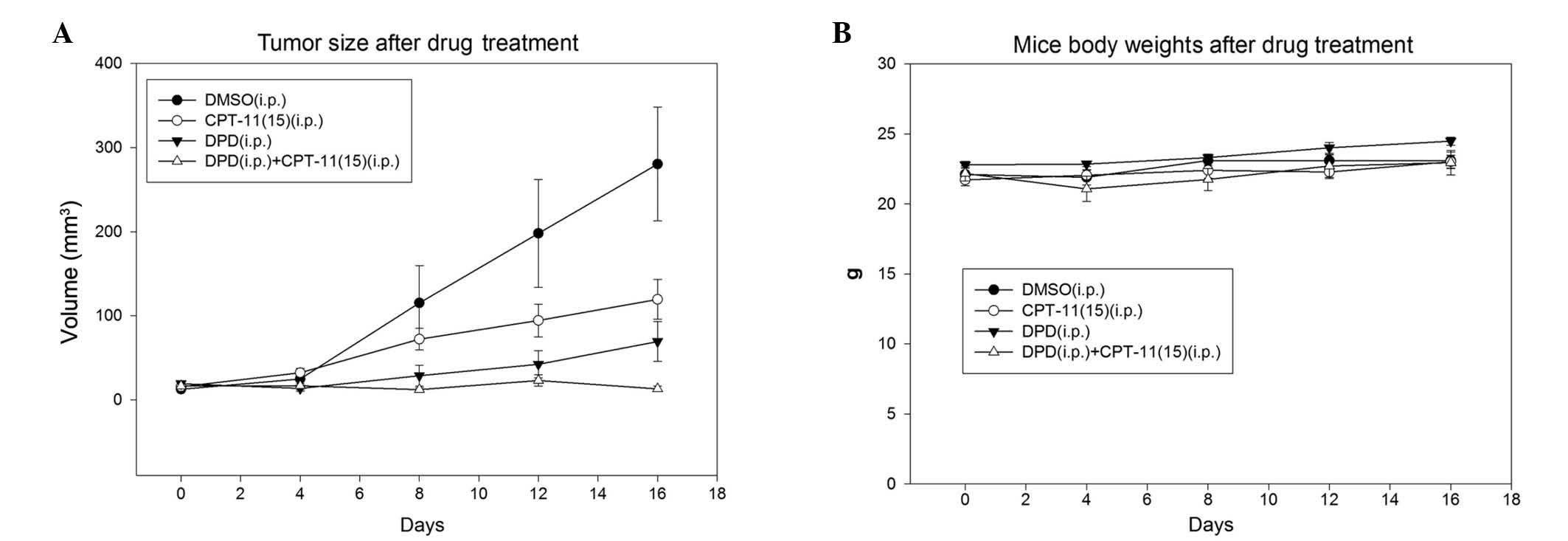|
1
|
Byeon JS, Yang SK, Kim TI, Kim WH, Lau JY,
Leung WK, Fujita R, Makharia GK, Abdullah M, Hilmi I, et al:
Colorectal neoplasm in asymptomatic Asians: A prospective
multinational multicenter colonoscopy survey. Gastrointest Endosc.
65:1015–1022. 2007. View Article : Google Scholar : PubMed/NCBI
|
|
2
|
Pham NM, Mizoue T, Tanaka K, Tsuji I,
Tamakoshi A, Matsuo K, Wakai K, Nagata C, Inoue M, Tsugane S, et
al: Meat consumption and colorectal cancer risk: An evaluation
based on a systematic review of epidemiologic evidence among the
Japanese population. Jpn J Clin Oncol. 44:641–650. 2014. View Article : Google Scholar : PubMed/NCBI
|
|
3
|
Wasserman E, Myara A, Lokiec F, Goldwasser
F, Trivin F, Mahjoubi M, Misset JL and Cvitkovic E: Severe CPT-11
toxicity in patients with Gilbert's syndrome: Two case reports. Ann
Oncol. 8:1049–1051. 1997. View Article : Google Scholar : PubMed/NCBI
|
|
4
|
Saltz LB, Clarke S, Díaz-Rubio E,
Scheithauer W, Figer A, Wong R, Koski S, Lichinitser M, Yang TS,
Rivera F, et al: Bevacizumab in combination with oxaliplatin-based
chemotherapy as first-line therapy in metastatic colorectal cancer:
A randomized phase III study. J Clin Oncol. 26:2013–2019. 2008.
View Article : Google Scholar : PubMed/NCBI
|
|
5
|
Aggarwal BB, Takada Y and Oommen OV: From
chemoprevention to chemotherapy: Common targets and common goals.
Expert Opin Investig Drugs. 13:1327–1338. 2004. View Article : Google Scholar : PubMed/NCBI
|
|
6
|
Robert J and Rivory L: Pharmacology of
irinotecan. Drugs Today (Barc). 34:777–803. 1998. View Article : Google Scholar : PubMed/NCBI
|
|
7
|
Kawato Y, Furuta T, Aonuma M, Yasuoka M,
Yokokura T and Matsumoto K: Antitumor activity of a camptothecin
derivative, CPT-11, against human tumor xenografts in nude mice.
Cancer Chemother Pharmacol. 28:192–198. 1991. View Article : Google Scholar : PubMed/NCBI
|
|
8
|
Houghton PJ, Cheshire PJ, Hallman JD II,
Lutz L, Friedman HS, Danks MK and Houghton JA: Efficacy of
topoisomerase I inhibitors, topotecan and irinotecan, administered
at low dose levels in protracted schedules to mice bearing
xenografts of human tumors. Cancer Chemother Pharmacol. 36:393–403.
1995. View Article : Google Scholar : PubMed/NCBI
|
|
9
|
Karato A, Sasaki Y, Shinkai T, Eguchi K,
Tamura T, Ohe Y, Oshita F, Nishio M, Kunikane H, Arioka H, et al:
Phase I study of CPT-11 and etoposide in patients with refractory
solid tumors. J Clin Oncol. 11:2030–2035. 1993.PubMed/NCBI
|
|
10
|
Armand JP, Terret C, Couteau C and Rixe O:
CPT-11. The European experience. Ann NY Acad Sci. 803:282–291.
1996. View Article : Google Scholar : PubMed/NCBI
|
|
11
|
Rothenberg ML: Irinotecan (CPT-11): Recent
developments and future directions - colorectal cancer and beyond.
Oncologist. 6:66–80. 2001. View Article : Google Scholar : PubMed/NCBI
|
|
12
|
Gamelin E, Gamelin L, Bossi L and
Quasthoff S: Clinical aspects and molecular basis of oxaliplatin
neurotoxicity: Current management and development of preventive
measures. Semin Oncol. 29(5 Suppl 15): 21–33. 2002. View Article : Google Scholar : PubMed/NCBI
|
|
13
|
Hecht JR: Gastrointestinal toxicity or
irinotecan. Oncology (Williston Park). 12(8 Suppl 6): 72–78.
1998.PubMed/NCBI
|
|
14
|
Chen CSH, Shen DM and Wentzek SE:
Preparation of adamantane and diamantane derivatives as antivirals.
Patent WO 9428885 Al. 1994.
|
|
15
|
Chen CSHSD and Wentzek SE: Preparation of
adamantane and diamantane derivatives as antivirals. WO 9428885 Al
(patent). 1994.
|
|
16
|
Wang JJ, Huang KT and Chern YT: Induction
of growth inhibition and G1 arrest in human cancer cell lines by
relatively low-toxic diamantane derivatives. Anticancer Drugs.
15:277–286. 2004. View Article : Google Scholar : PubMed/NCBI
|
|
17
|
Wang JJ, Chang YF, Chern YT and Chi CW:
Study of in vitro and in vivo effects of 1,6-Bis
[4-(4-amino-3-hydroxyphenoxy)phenyl] diamantane (DPD), a novel
cytostatic and differentiation inducing agent, on human colon
cancer cells. Br J Cancer. 89:1995–2003. 2003. View Article : Google Scholar : PubMed/NCBI
|
|
18
|
Chang YF, Chi CW, Chern YT and Wang JJ:
Effects of 1,6-Bis [4-(4-amino-3-hydroxyphenoxy) phenyl] diamantane
(DPD), a reactive oxygen species and apoptosis inducing agent, on
human leukemia cells in vitro and in vivo. Toxicol
Appl Pharmacol. 202:1–12. 2005. View Article : Google Scholar : PubMed/NCBI
|
|
19
|
National Research Council: Guide for the
Care and Use of Laboratory Animals (8th). The National Academies
Press. Washington, DC: 2011.
|
|
20
|
Holbeck SL, Collins JM and Doroshow JH:
Analysis of food and drug administration-approved anticancer agents
in the NCI60 panel of human tumor cell lines. Mol Cancer Ther.
9:1451–1460. 2010. View Article : Google Scholar : PubMed/NCBI
|
|
21
|
United Kingdom Co-ordinating Committee on
Cancer Research (UKCCCR) Guidelines for the Welfare of Animals in
Experimental Neoplasia (Second Edition). Br J Cancer. 77:1–10.
1998. View Article : Google Scholar
|
|
22
|
Attia MA and Weiss DW: Immunology of
spontaneous mammary carcinomas in mice. V. Acquired tumor
resistance and enhancement in strain A mice infected with mammary
tumor virus. Cancer Res. 26:1787–1800. 1966.PubMed/NCBI
|
|
23
|
Wang JJ, Lee JY, Chen YC, Chern YT and Chi
CW: The antitumor effect of a novel differentiation inducer,
2,2-Bis (4-(4-amino-3-hydroxyphenoxy) phenyl) adamantane (DPA), in
combinatory therapy on human colon cancer. Int J Oncol.
28:1003–1012. 2006.PubMed/NCBI
|
|
24
|
Singh RP, Dhanalakshmi S and Agarwal R:
Phytochemicals as cell cycle modulators-a less toxic approach in
halting human cancers. Cell Cycle. 1:156–161. 2002. View Article : Google Scholar : PubMed/NCBI
|
|
25
|
Kaufmann SH and Earnshaw WC: Induction of
apoptosis by cancer chemotherapy. Exp Cell Res. 256:42–49. 2000.
View Article : Google Scholar : PubMed/NCBI
|
|
26
|
Makin G and Hickman JA: Apoptosis and
cancer chemotherapy. Cell Tissue Res. 301:143–152. 2000. View Article : Google Scholar : PubMed/NCBI
|
|
27
|
Cotter TG: Apoptosis and cancer: The
genesis of a research field. Nat Rev Cancer. 9:501–507. 2009.
View Article : Google Scholar : PubMed/NCBI
|
|
28
|
Wang R, Ma L, Weng D, Yao J, Liu X and Jin
F: Gallic acid induces apoptosis and enhances the anticancer
effects of cisplatin in human small cell lung cancer H446 cell line
via the ROS-dependent mitochondrial apoptotic pathway. Oncol Rep.
Mar 17–2016.(Epub ahead of print). View Article : Google Scholar
|
|
29
|
Khuda-Bukhsh AR, Das S and Saha SK:
Molecular approaches toward targeted cancer prevention with some
food plants and their products: Inflammatory and other signal
pathways. Nutr Cancer. 66:194–205. 2014. View Article : Google Scholar : PubMed/NCBI
|
|
30
|
Zhang L and Yu J: Role of apoptosis in
colon cancer biology, therapy, and prevention. Curr Colorectal
Cancer Rep. 9:2013. View Article : Google Scholar
|
|
31
|
Lavrik IN, Golks A and Krammer PH:
Caspases: Pharmacological manipulation of cell death. J Clin
Invest. 115:2665–2672. 2005. View
Article : Google Scholar : PubMed/NCBI
|
|
32
|
Woo M, Hakem R, Soengas MS, Duncan GS,
Shahinian A, Kägi D, Hakem A, McCurrach M, Khoo W, Kaufman SA, et
al: Essential contribution of caspase 3/CPP32 to apoptosis and its
associated nuclear changes. Genes Dev. 12:806–819. 1998. View Article : Google Scholar : PubMed/NCBI
|
|
33
|
Slee EA, Adrain C and Martin SJ:
Executioner caspase-3, −6, and −7 perform distinct, non-redundant
roles during the demolition phase of apoptosis. J Biol Chem.
276:7320–7326. 2001. View Article : Google Scholar : PubMed/NCBI
|
|
34
|
Looi CY, Arya A, Cheah FK, et al:
Induction of apoptosis in human breast cancer cells via caspase
pathway by vernodalin isolated from Centratherum
anthelminticum (L.) seeds. PloS One. 8:e566432013. View Article : Google Scholar : PubMed/NCBI
|
|
35
|
Lin Y, Bai L, Chen W and Xu S: The
NF-kappaB activation pathways, emerging molecular targets for
cancer prevention and therapy. Expert Opin Ther Targets. 14:45–55.
2010. View Article : Google Scholar : PubMed/NCBI
|
|
36
|
Zhou S, Li N, Wang X, et al: In
vitro cytotoxicity, pharmacokinetics and tissue distribution in
rats of MXN-004, a novel conjugate of polyethylene glycol and SN38.
Xenobiotica. 44:562–569. 2014. View Article : Google Scholar : PubMed/NCBI
|

















